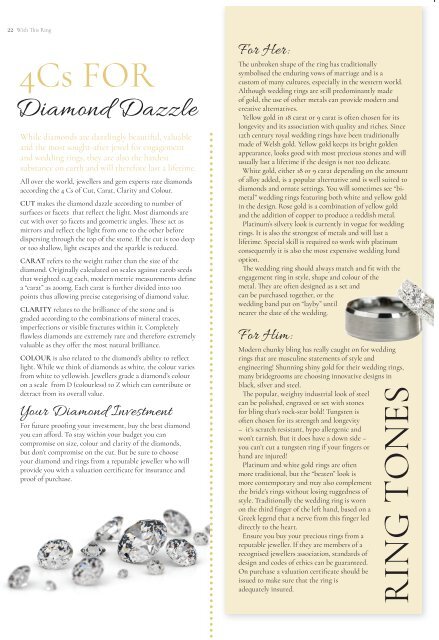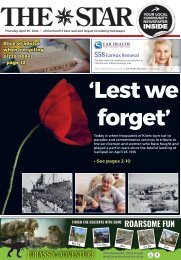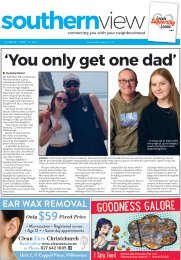With This Ring: March 23, 2018
You also want an ePaper? Increase the reach of your titles
YUMPU automatically turns print PDFs into web optimized ePapers that Google loves.
22 <strong>With</strong> <strong>This</strong> <strong>Ring</strong><br />
4Cs FOR<br />
Diamond Dazzle<br />
While diamonds are dazzlingly beautiful, valuable<br />
and the most sought-after jewel for engagement<br />
and wedding rings, they are also the hardest<br />
substance on earth and will therefore last a lifetime.<br />
All over the world, jewellers and gem experts rate diamonds<br />
according the 4 Cs of Cut, Carat, Clarity and Colour.<br />
CUT makes the diamond dazzle according to number of<br />
surfaces or facets that reflect the light. Most diamonds are<br />
cut with over 50 facets and geometric angles. These act as<br />
mirrors and reflect the light from one to the other before<br />
dispersing through the top of the stone. If the cut is too deep<br />
or too shallow, light escapes and the sparkle is reduced.<br />
CARAT refers to the weight rather than the size of the<br />
diamond. Originally calculated on scales against carob seeds<br />
that weighted 0.2g each, modern metric measurements define<br />
a “carat” as 200mg. Each carat is further divided into 100<br />
points thus allowing precise categorising of diamond value.<br />
CLARITY relates to the brilliance of the stone and is<br />
graded according to the combinations of mineral traces,<br />
imperfections or visible fractures within it. Completely<br />
flawless diamonds are extremely rare and therefore extremely<br />
valuable as they offer the most natural brilliance.<br />
COLOUR is also related to the diamond’s ability to reflect<br />
light. While we think of diamonds as white, the colour varies<br />
from white to yellowish. Jewellers grade a diamond’s colour<br />
on a scale from D (colourless) to Z which can contribute or<br />
detract from its overall value.<br />
Your Diamond Investment<br />
For future proofing your investment, buy the best diamond<br />
you can afford. To stay within your budget you can<br />
compromise on size, colour and clarity of the diamonds,<br />
but don’t compromise on the cut. But be sure to choose<br />
your diamond and rings from a reputable jeweller who will<br />
provide you with a valuation certificate for insurance and<br />
proof of purchase.<br />
For Her:<br />
The unbroken shape of the ring has traditionally<br />
symbolised the enduring vows of marriage and is a<br />
custom of many cultures, especially in the western world.<br />
Although wedding rings are still predominantly made<br />
of gold, the use of other metals can provide modern and<br />
creative alternatives.<br />
Yellow gold in 18 carat or 9 carat is often chosen for its<br />
longevity and its association with quality and riches. Since<br />
12th century royal wedding rings have been traditionally<br />
made of Welsh gold. Yellow gold keeps its bright golden<br />
appearance, looks good with most precious stones and will<br />
usually last a lifetime if the design is not too delicate.<br />
White gold, either 18 or 9 carat depending on the amount<br />
of alloy added, is a popular alternative and is well suited to<br />
diamonds and ornate settings. You will sometimes see “bimetal”<br />
wedding rings featuring both white and yellow gold<br />
in the design. Rose gold is a combination of yellow gold<br />
and the addition of copper to produce a reddish metal.<br />
Platinum’s silvery look is currently in vogue for wedding<br />
rings. It is also the strongest of metals and will last a<br />
lifetime. Special skill is required to work with platinum<br />
consequently it is also the most expensive wedding band<br />
option.<br />
The wedding ring should always match and fit with the<br />
engagement ring in style, shape and colour of the<br />
metal. They are often designed as a set and<br />
can be purchased together, or the<br />
wedding band put on “layby” until<br />
nearer the date of the wedding.<br />
For Him:<br />
Modern chunky bling has really caught on for wedding<br />
rings that are masculine statements of style and<br />
engineering! Shunning shiny gold for their wedding rings,<br />
many bridegrooms are choosing innovative designs in<br />
black, silver and steel.<br />
The popular, weighty industrial look of steel<br />
can be polished, engraved or set with stones<br />
for bling that’s rock-star bold! Tungsten is<br />
often chosen for its strength and longevity<br />
– it’s scratch resistant, hypo allergenic and<br />
won’t tarnish. But it does have a down side –<br />
you can’t cut a tungsten ring if your fingers or<br />
hand are injured!<br />
Platinum and white gold rings are often<br />
more traditional, but the “beaten” look is<br />
more contemporary and may also complement<br />
the bride’s rings without losing ruggedness of<br />
style. Traditionally the wedding ring is worn<br />
on the third finger of the left hand, based on a<br />
Greek legend that a nerve from this finger led<br />
directly to the heart.<br />
Ensure you buy your precious rings from a<br />
reputable jeweller. If they are members of a<br />
recognised jewellers association, standards of<br />
design and codes of ethics can be guaranteed.<br />
On purchase a valuation certificate should be<br />
issued to make sure that the ring is<br />
adequately insured.<br />
RING TONES


















